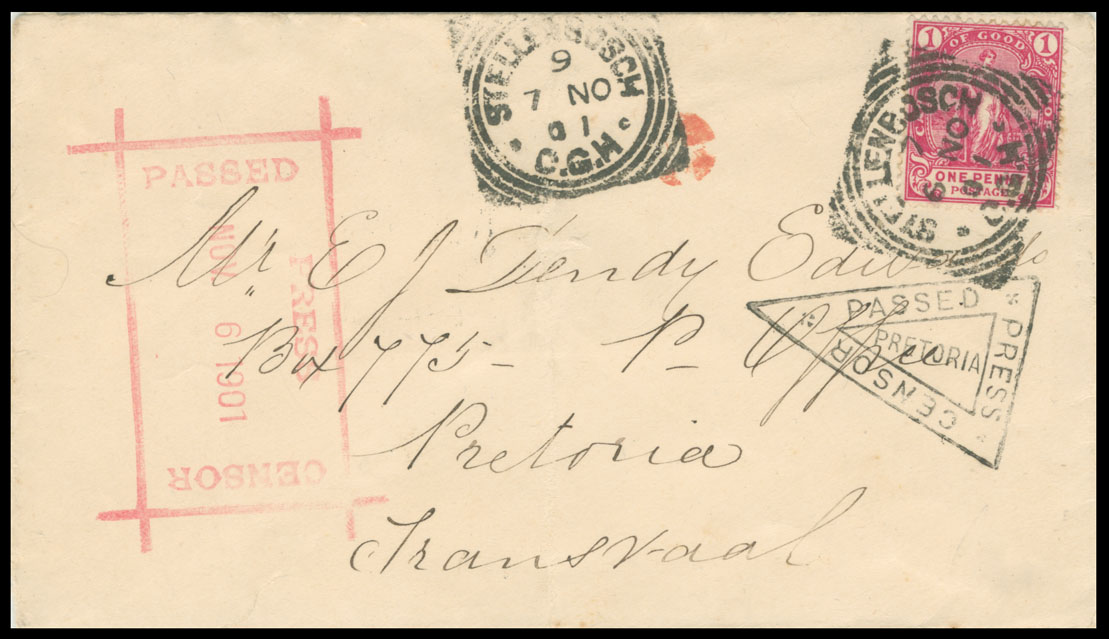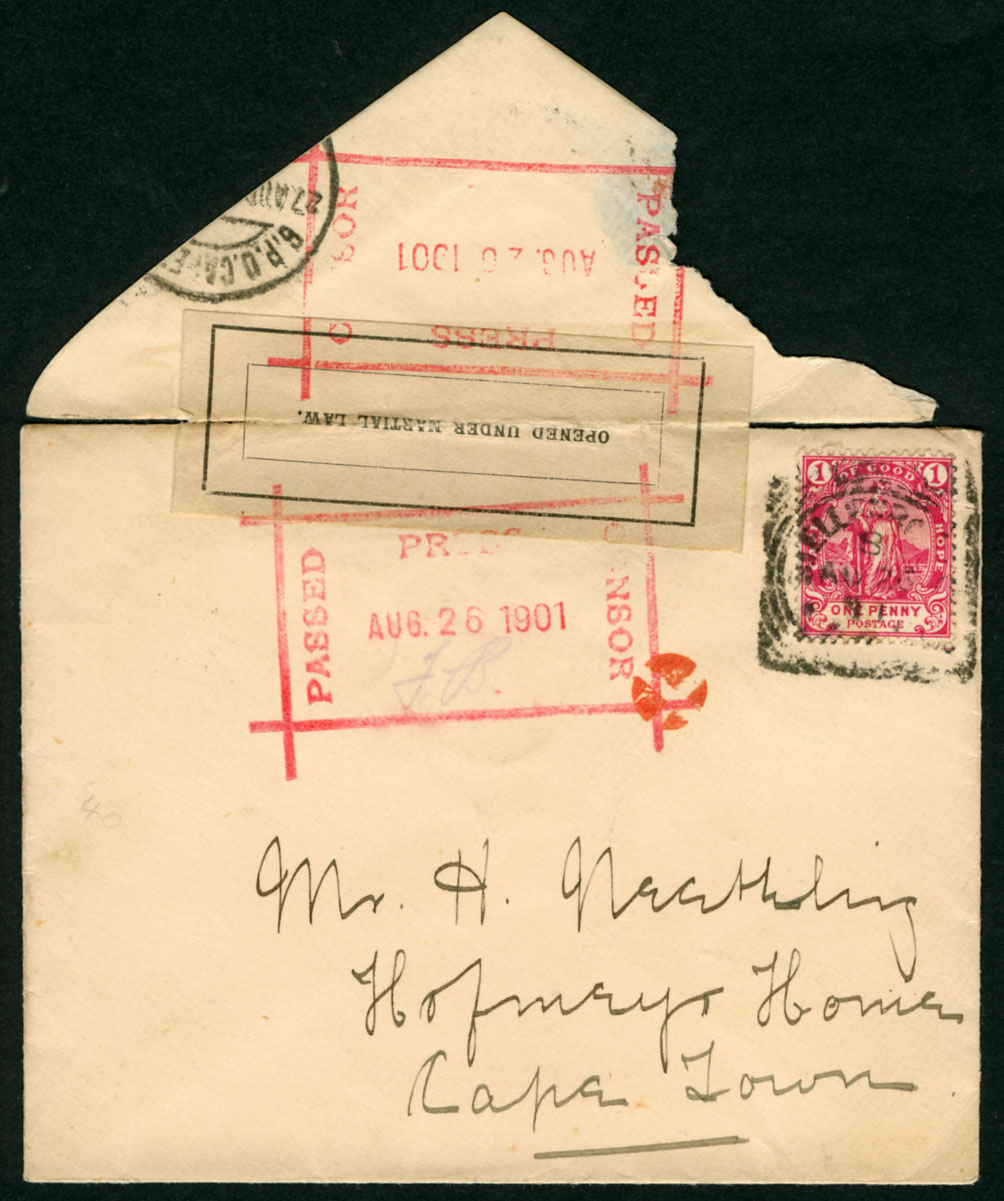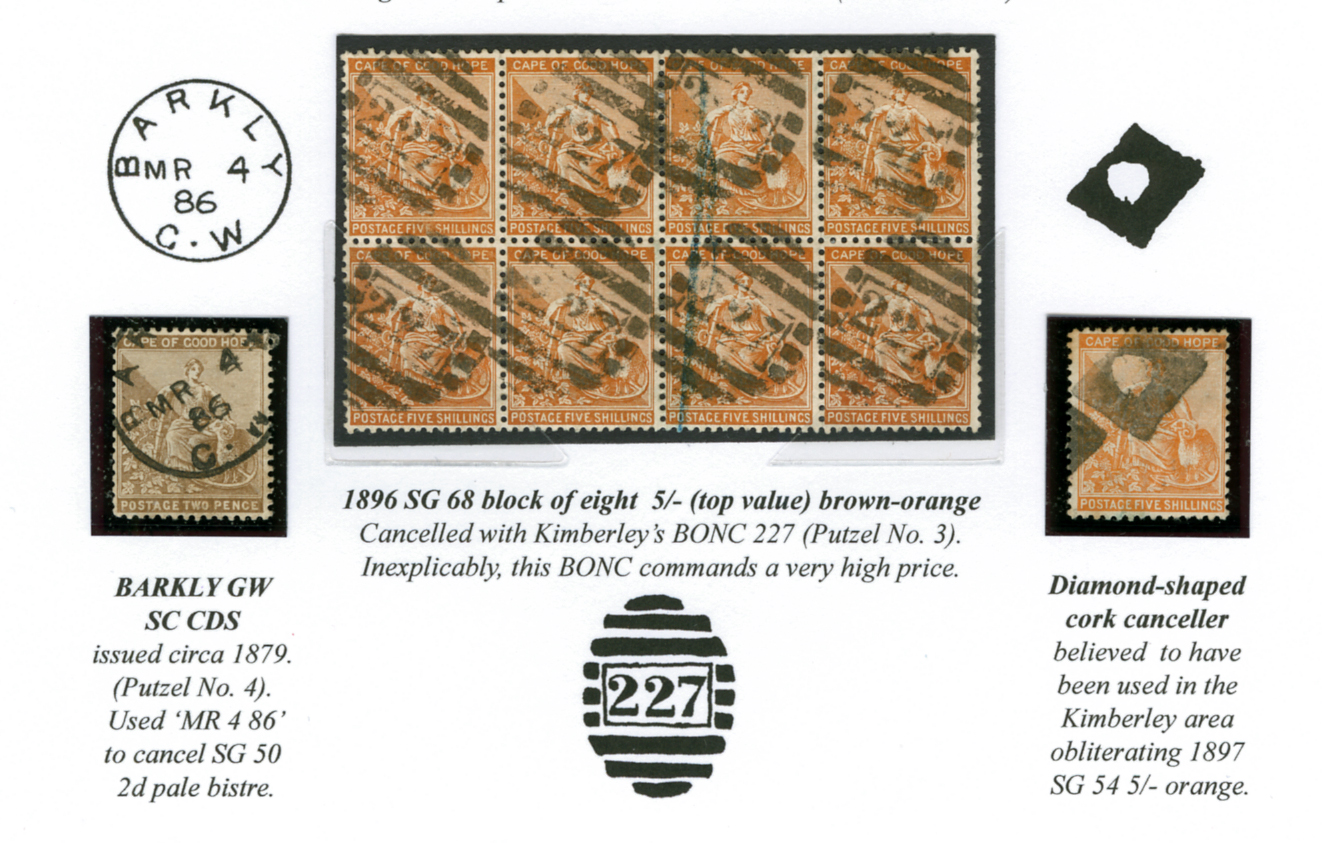Cape of Good Hope: Cork Cancellations
Quote from Steve on January 3, 2023, 6:59 pmThese covers below do not show cork cancellers. The small orange 'buns' are discreet cork markers or identifiers. However, their method of manufacture was much the same as a 'cork canceller'. They have been made from the cork of presumably a small bottle. The cork has been quartered unevenly, as is often the way with such ad hoc solutions.
What their purpose was, I do not know but I guess they show that the letter was either to be censored or had been censored. It was an office admin mark. The two examples below and the one in Gawie Hugo's 'Table Mountain, The Inspiration' display, are the only examples I have seen. There must be more. As all three covers are from Stellenbosch, I assume that these office admin marks were applied there, not elsewhere as Gawie states.
The dates of my three recorded covers are: 26 August 1901; 21 September 1901 and 7 November 1901. Only the earliest cover has an 'OPENED UNDER MARTIAL LAW." label. Had they run out of labels by 21st September or were they no longer a requirement? If anyone has another example or knowledge of this, please share it with us here.
I have a theory. During the South African War there was a large Remount centre in Stellenbosch. Horses were key to mobility among the combatants by late 1901 when these covers were 'marked'. In April 1901, General Jan Smuts had invaded the Cape Colony. Born in Riebeek West in 1870, some 75km from Cape Town, he was educated in Stellenbosch. He rallied some 3,000 Cape Boers to the Republican cause, including my great uncle Elias Nel from Calvinia. For a time some of his Boer forces were based in the Hex River Valley, some 70 miles (112km) from Stellenbosch. At one point Smuts was said to be close enough to Cape Town to see Table Mountain. The possibility of Smuts capturing Stellenbosch and its Remount horses and igniting a wider rebellion among the Cape Dutch sent the British into a 'flap' between August and November 1901. Even Cape Town was a bit panicked at this time by the proximity of Boer forces. To reassure the citizenry extra security measures were introduced. Perhaps one was the tightening up of censorship. Letters from Stellenbosh were either marked with the small orange cork identifier to show they were yet to be censored, or more likely as all mail had to be censored, that the letter had already been censored and was approved for posting. This theory may have nothing to do with Jan Smuts or cork cancellers as we know them! If we could find earlier examples to show this was normal procedure, my theory would evaporate like Karoo rain.
These covers below do not show cork cancellers. The small orange 'buns' are discreet cork markers or identifiers. However, their method of manufacture was much the same as a 'cork canceller'. They have been made from the cork of presumably a small bottle. The cork has been quartered unevenly, as is often the way with such ad hoc solutions.
What their purpose was, I do not know but I guess they show that the letter was either to be censored or had been censored. It was an office admin mark. The two examples below and the one in Gawie Hugo's 'Table Mountain, The Inspiration' display, are the only examples I have seen. There must be more. As all three covers are from Stellenbosch, I assume that these office admin marks were applied there, not elsewhere as Gawie states.
The dates of my three recorded covers are: 26 August 1901; 21 September 1901 and 7 November 1901. Only the earliest cover has an 'OPENED UNDER MARTIAL LAW." label. Had they run out of labels by 21st September or were they no longer a requirement? If anyone has another example or knowledge of this, please share it with us here.
I have a theory. During the South African War there was a large Remount centre in Stellenbosch. Horses were key to mobility among the combatants by late 1901 when these covers were 'marked'. In April 1901, General Jan Smuts had invaded the Cape Colony. Born in Riebeek West in 1870, some 75km from Cape Town, he was educated in Stellenbosch. He rallied some 3,000 Cape Boers to the Republican cause, including my great uncle Elias Nel from Calvinia. For a time some of his Boer forces were based in the Hex River Valley, some 70 miles (112km) from Stellenbosch. At one point Smuts was said to be close enough to Cape Town to see Table Mountain. The possibility of Smuts capturing Stellenbosch and its Remount horses and igniting a wider rebellion among the Cape Dutch sent the British into a 'flap' between August and November 1901. Even Cape Town was a bit panicked at this time by the proximity of Boer forces. To reassure the citizenry extra security measures were introduced. Perhaps one was the tightening up of censorship. Letters from Stellenbosh were either marked with the small orange cork identifier to show they were yet to be censored, or more likely as all mail had to be censored, that the letter had already been censored and was approved for posting. This theory may have nothing to do with Jan Smuts or cork cancellers as we know them! If we could find earlier examples to show this was normal procedure, my theory would evaporate like Karoo rain.
Uploaded files:Quote from Steve on January 8, 2023, 1:12 pmI found this in a 'Discovery of Diamonds' display. I think the comment that the diamond-shaped cork canceller was used in Kimberley is 'interesting' but, like all things to do with Cape cork canceller's, "where's the bloody horse?".
I found this in a 'Discovery of Diamonds' display. I think the comment that the diamond-shaped cork canceller was used in Kimberley is 'interesting' but, like all things to do with Cape cork canceller's, "where's the bloody horse?".
Uploaded files:Quote from Jamie Smith on January 8, 2023, 1:36 pmAnd I thought 'Cork' Cancellers were Irish! (There was supposed to be a smiley there but don't know where to get it from!).
And I thought 'Cork' Cancellers were Irish! (There was supposed to be a smiley there but don't know where to get it from!).
Quote from Steve on May 26, 2024, 10:25 amQ: Why does an Irishman wear two condoms?
A: 'To be sure, to be sure!'
I have now received the items below and as promised earlier I have replaced the internet copy with a decent scan. The item that has got me excited most is the CoGH 1/- green stamp with single 'bun' cork canceller. It is perforated with initials ascribed to 'Bagshaw, Gibaud and Co.' of Port Elizabeth. (BGL on perfin.) This suggests but does not conclusively prove that this cork canceller was used in PE. What this post does prove is the desperate measures cork canceller collectors go to to grasp at straws that suggest provenance.
The other two Cape cork canceller items are also nice to have. I believe that rather than using the top of a cork to make the canceller that worked like to standard handstamp that was pressed downwards onto the paper, these were cut into the body (length) of the cork and then rolled like a barrel over the parcel. This may have required a device rather like the roller shown. The cork or soft wood wood have been drilled through the centre allowing it to turn on a shaft. It should be easy to recreate. Perhaps when I have an idle moment I will do so.
Q: Why does an Irishman wear two condoms?
A: 'To be sure, to be sure!'
I have now received the items below and as promised earlier I have replaced the internet copy with a decent scan. The item that has got me excited most is the CoGH 1/- green stamp with single 'bun' cork canceller. It is perforated with initials ascribed to 'Bagshaw, Gibaud and Co.' of Port Elizabeth. (BGL on perfin.) This suggests but does not conclusively prove that this cork canceller was used in PE. What this post does prove is the desperate measures cork canceller collectors go to to grasp at straws that suggest provenance.
The other two Cape cork canceller items are also nice to have. I believe that rather than using the top of a cork to make the canceller that worked like to standard handstamp that was pressed downwards onto the paper, these were cut into the body (length) of the cork and then rolled like a barrel over the parcel. This may have required a device rather like the roller shown. The cork or soft wood wood have been drilled through the centre allowing it to turn on a shaft. It should be easy to recreate. Perhaps when I have an idle moment I will do so.
Uploaded files:




